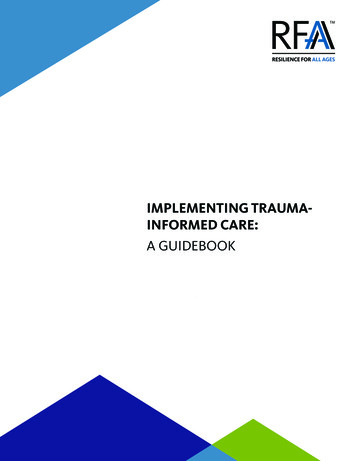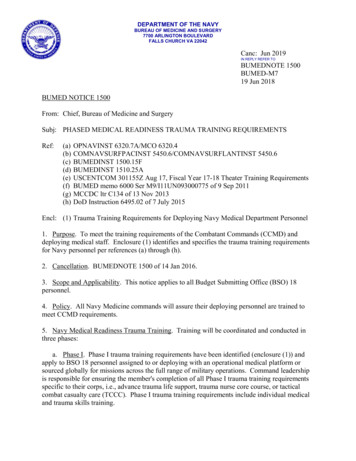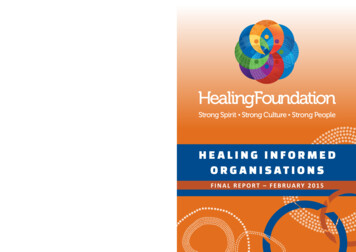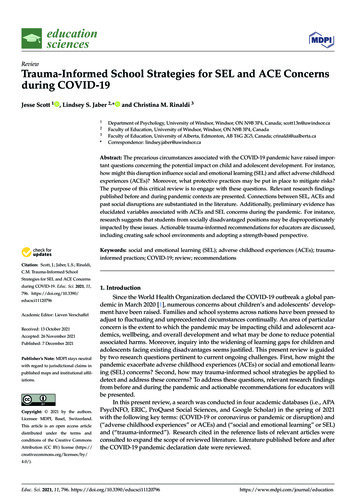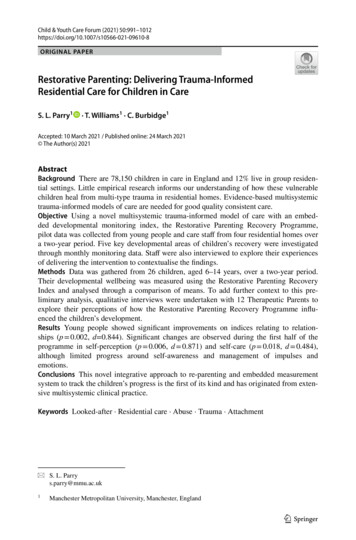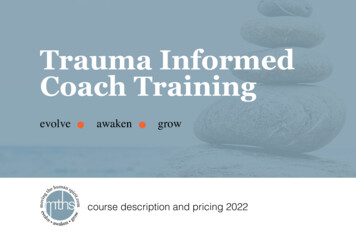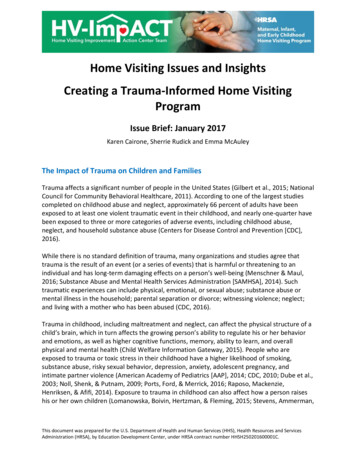
Transcription
Home Visiting Issues and InsightsCreating a Trauma-Informed Home VisitingProgramIssue Brief: January 2017Karen Cairone, Sherrie Rudick and Emma McAuleyThe Impact of Trauma on Children and FamiliesTrauma affects a significant number of people in the United States (Gilbert et al., 2015; NationalCouncil for Community Behavioral Healthcare, 2011). According to one of the largest studiescompleted on childhood abuse and neglect, approximately 66 percent of adults have beenexposed to at least one violent traumatic event in their childhood, and nearly one-quarter havebeen exposed to three or more categories of adverse events, including childhood abuse,neglect, and household substance abuse (Centers for Disease Control and Prevention [CDC],2016).While there is no standard definition of trauma, many organizations and studies agree thattrauma is the result of an event (or a series of events) that is harmful or threatening to anindividual and has long-term damaging effects on a person’s well-being (Menschner & Maul,2016; Substance Abuse and Mental Health Services Administration [SAMHSA], 2014). Suchtraumatic experiences can include physical, emotional, or sexual abuse; substance abuse ormental illness in the household; parental separation or divorce; witnessing violence; neglect;and living with a mother who has been abused (CDC, 2016).Trauma in childhood, including maltreatment and neglect, can affect the physical structure of achild’s brain, which in turn affects the growing person’s ability to regulate his or her behaviorand emotions, as well as higher cognitive functions, memory, ability to learn, and overallphysical and mental health (Child Welfare Information Gateway, 2015). People who areexposed to trauma or toxic stress in their childhood have a higher likelihood of smoking,substance abuse, risky sexual behavior, depression, anxiety, adolescent pregnancy, andintimate partner violence (American Academy of Pediatrics [AAP], 2014; CDC, 2010; Dube et al.,2003; Noll, Shenk, & Putnam, 2009; Ports, Ford, & Merrick, 2016; Raposo, Mackenzie,Henriksen, & Afifi, 2014). Exposure to trauma in childhood can also affect how a person raiseshis or her own children (Lomanowska, Boivin, Hertzman, & Fleming, 2015; Stevens, Ammerman,This document was prepared for the U.S. Department of Health and Human Services (HHS), Health Resources and ServicesAdministration (HRSA), by Education Development Center, under HRSA contract number HHSH250201600001C.
Putnam, & Van Ginkel, 2002). Prolonged trauma can affect a person’s relationships with othersand is associated with high parental stress, severe parenting attitudes, a greater risk for childabuse, and disrupted attachment with the child (AAP, 2014; Ammerman et al., 2013;Lomanowska et al., 2015; McKelvey, Whiteside-Mansell, Conners-Burrow, Swindle, & Fitzgerald,2016).The Prevalence of Trauma in Families Served by Home Visiting ProgramsHome visiting programs often reach families who have the highest level of need. For example,according to Stevens et al. (2002), approximately 70 percent of the women surveyed in a homevisiting program had experienced at least one violent trauma in their lifetime. Mothers in homevisiting programs have also been found to have more elevated rates of depression than those ofthe general population (Ammerman, Putnam, Bosse, Teeters, & Van Ginkel, 2010).The Mother and Infant Home Visiting Program Evaluation (MIHOPE) is one of the largestrandom-assignment studies to date that assesses the effectiveness of home visiting programs inimproving a variety of outcomes, including maternal health and child development (MDRC,2016). Launched in 2011, MIHOPE plans to recruit more than 4,000 families, randomly assigningthem to either a Federal Home Visiting Program (also known as Maternal, Infant and EarlyChildhood Home Visiting, or MIECHV) or another community service (Michaelopoulos et al.,2015). Initial findings, taken from surveying the first 1,600 mothers enrolled in the evaluation,found that 10 percent had experienced intimate partner violence in the past year andapproximately 40 percent exhibited symptoms of depression or anxiety (Michaelopoulos et al.,2015; Office of Planning, Research, and Evaluation, 2016).Both the rate and the likelihood of trauma exposure among children are also significantlyaffected by a variety of community factors. In both rural and urban areas, children living in lowincome communities are far more likely to experience violence and trauma (U.S. Department ofJustice, 2012). This can be compounded by the fact that impoverished communities often donot have access to the necessary resources to help caregivers address the effects of suchtrauma on children’s development (U.S. Department of Justice, 2012). As over three-quarters offamilies in MIECHV live at or below 100 percent of the Federal Poverty Guidelines, thesecommunity factors and how they can affect childhood development is significant for homevisiting (Health Resources & Services Administration, 2015).The Importance of Trauma-Informed Approaches in Home Visiting ProgramsA trauma-informed approach is one way that home visiting organizations are teaching theirstaff to recognize the effects of trauma and to work with families in a thoughtful way. TraumaInformed Care is a perspective through which an organization realizes the impact of trauma onits families, recognizes the signs of trauma, and uses that understanding to improve clientengagement, outcomes, and organizational services (Menschner & Maul, 2016; SAMHSA,2014). According to Kennedy (2015), “In its simplest form, trauma-informed care is a way ofthinking about and responding to families’ struggles” (p. 1).HomeVisiting@hrsa.gov2
Home visiting can play an important role in alleviating the intergenerational transmission oftrauma by helping parents and caregivers build positive and healthy attachments with theirchildren. A safe environment and nurturing relationships are two important protective factorsin a child’s life that can foster resilience and help to outweigh the long-term effects of trauma(AAP, 2014; CDC, 2014).A trauma-informed approach can also help prevent burnout and turnover among home visitingprogram staff, which ultimately impacts retention, success, and well-being among the familiesserved.Becoming a Trauma-Informed Home Visiting ProgramBuilding a trauma-informed home visiting program requires leadership, buy-in, self-knowledge,and intentionality. Programs must gather the right partners, ask important questions, anddevelop strong systems-level goals that focus on home visiting and early childhood communityneeds. In other words, it doesn’t happen overnight! As noted by JBS International Inc. and theGeorgetown University National Technical Assistance for Children’s Mental Health (2016),“Becoming a trauma-informed organization can be a lengthy, gradual process and one thatrequires ongoing effort” (p. 5).Consider the recommendations below and then ask yourself: Is our program as traumainformed as it needs to be? If not, what steps do we need to take to get started on or movefurther down this important path? Engage in deep, thoughtful reflection, discussion, and exploration of what it means tobe trauma-informed. Assess your organization’s readiness for change by taking a wide-ranging look at allaspects of the organization (e.g., developmental screening and surveillance, maternaland child mental health), and then make a plan of action. Train staff on recognizing the symptoms of trauma and how to talk to families about it. Incorporate screening for trauma, and ensure that those administering screening havebeen prepared to deliver it in a supportive way.Note: The National Center on Early Childhood Health and Wellness offers a numberof excellent resources on this; in particular, see Breaking Through: Video and User’sGuide to Understand and Address Toxic Stress. Integrate evidence-based practices for providing trauma-informed care, such as thoseavailable through the National Technical Assistance Center for Children’s Mental Health. Identify resources within the community; make strong connections and formpartnerships with community agencies that offer treatment and supports for familieswho have experienced or are experiencing trauma. Support the well-being of your staff as they work with high-risk families.HomeVisiting@hrsa.gov3
Promote awareness of the impact of childhood trauma by sharing issue briefs,infographics, and other publications within the community and through social media.Note: CDC’s informative and attention-grabbing graphics are one good way topromote awareness of the long-term effects of trauma.Snapshots of Success from the Field: Trauma-informed Approaches in HomeVisitingIn this Home Visiting Issues and Insights information brief, three voices from the field shareprocesses and resources that can support system-level change and sustained communityimpact: Leslie McAllister, Home Visiting Coordinator for the Wisconsin Department of Childrenand Families, describes the components of the National Child Traumatic StressNetwork’s trauma-informed child and family service system framework and how thisframework is implemented in the Wisconsin home visiting system. Lorrie Grevstad, Federal Project Officer, Region X, Division of Home Visiting and EarlyChildhood Systems, describes how the NEAR@Home Toolkit brings together evidencefrom Neuroscience, Epigenetics, Adverse Childhood Experiences, and Resilience andthen applies this science to home visiting. Jan Williams, Clinical Supervisor, Healthy Families Durham at the Center for Child andFamily Health, talks about the impact of secondary trauma on home visitors, strategiesfor preventing secondary trauma, and how to identify and support staff who experienceit.Snapshot 1: Integrating Trauma-Informed Principles Within Home Visiting SystemsLeslie McAllister, the MIECHV state lead, shares the Wisconsin Family Foundations HomeVisiting (FFHV) program’s approach for promoting trauma-informed practices in home visiting.FFHV has used the National Child Traumatic Stress Network (NCTSN) framework to develop amore trauma-informed statewide network of home visiting programs. According to NCTSN(n.d.), “A service system with a trauma-informed perspective is one in which programs,agencies, and service providers: Routinely screen for trauma exposure and related symptoms Use culturally appropriate evidence-based assessment and treatment for traumaticstress and associated mental health symptoms Make resources available to children, families, and providers on trauma exposure, itsimpact, and treatment Engage in efforts to strengthen the resilience and protective factors of children andfamilies impacted by and vulnerable to trauma Address parent and caregiver trauma and its impact on the family systemHomeVisiting@hrsa.gov4
Emphasize continuity of care and collaboration across child-service systems Maintain an environment of care for staff that addresses, minimizes, and treatssecondary traumatic stress, and that increases staff resilience.”McAllister notes the importance of examining and strengthening the overall organization’sculture and philosophy regarding trauma practices, as well as the importance of workingdirectly with children and families. Several studies and organizations (Davis & Maul, 2015;Kennedy, 2015; Menschner & Maul, 2016; NCTSN, n.d.) recommend Trauma-Informed Care(TIC) principles for adjusting both an organization’s culture and its direct-service processes.FFHV applies TIC principles by doing the following: Incorporating specific and layered training and supports for staff and supervisors onparticipant-centered screening and assessment practices Offering monthly groups that are facilitated by a trained infant mental health consultantand that build reflective capacity among staff and supervisors Creating communities of practice that provide a regular venue for peer-to-peer support Integrating information, resources, and activities for parents into home visits Providing opportunities for group socialization, which promotes protective factors thatcan strengthen families and support children’s optimal social and emotionaldevelopment Providing additional professional development opportunities for staff (through theMaternal Depression Project, among other important resources) to more effectivelysupport mothers with significant trauma histories who are at risk for maternaldepression or anxietyWisconsin’s FFHV incorporates a variety of screens, including the ASQ-SE2 and the ChildhoodExperiences Survey—a tool developed by the state’s evaluation team to measure an array ofpotentially traumatic childhood events experienced by parents in home visiting services. Basedon concerns noted by program staff, the state and its evaluation and training/technicalassistance (TA) partners have identified several strategies—including tip sheets and othermaterials, on-site coaching, webinars, and a one-day training for supervisors—to help supportmore confident and competent administration of these tools. McAllister notes that in this way,the state and its partners have helped home visitors become more attuned to both childrenand parents during the home visit. By clarifying for staff how knowledge of a participant’strauma history can enhance case planning and services, they have also helped to ensure thatservices are consistent with TIC principles.Reflective practice groups and communities of practice help home visitors learn more abouthow their own experiences shape their interactions with families, while also providingopportunities to discuss and solve problems around issues related to burnout, compassionfatigue, secondary trauma, and strategies to more meaningfully engage with the high-needsfamilies they serve.HomeVisiting@hrsa.gov5
As part of its trauma-informed approach, with a focus on building child and family resilience,Wisconsin has recently begun to more intentionally integrate the Strengthening Familiesframework into home visiting practice and professional development. For example, theintroductory training, Home Visitation Foundations, has been updated to reflect goals forpractice-grounded TIC principles and promotion of the protective factors that research hasshown mitigate the negative impact of trauma. At the program level, while staff use their homevisits to address trauma and child development, they have also partnered with local early careand education programs to engage parents in meaningful conversation and positive socialinteraction through parent-led Parent Cafes that use the Strengthening Families framework.McAllister adds that The Maternal Depression Project helps address the needs of mothers withsignificant trauma histories who are at risk for depression, as well as their babies. Participatinghome visiting program staff receives intensive training and TA—both in vivo and through theuse of video replay—from experienced infant mental health practitioners on dyadic coaching topromote healthy parent-child relationships. This has been instrumental in increasing theconfidence of home visiting program staff to work with mothers with the mental health issuesthat go hand-in-hand with exposure to trauma, while also providing meaningful and culturallyrespectful parenting support for very high-risk mothers.Snapshot 2: Addressing TIC at the Regional Level with a ToolkitA good name for the story shared by Federal Project Officer, Lorrie Grevstad, is “It takes aregion.” Grevstad shares that the four states in Region X, supported by their Project Officer, TASpecialist, and two experts with deep knowledge of and experience with NEAR (Neuroscience,Epigenetics, Adverse Childhood Experiences, and Resilience) science and ACES (AdverseChildhood Experiences) research and practice, took the seed of an idea about bringing togetherthe four aspects of NEAR science and transforming them into a practical tool for home visitingprograms and home visitors.Grevstad remembers that it all began at a 2010 regional meeting, right at the start of theMIECHV Program, when ACE Interface LLC co-founder Laura Porter presented a plenary sessionon ACES that really hit home with many conference attendees. ACES continued to be a themeand a topic of conversation at regional meetings. Then, during a 2013 regional meeting, staterecipients made a collective decision to transform their conversations into action. An ACESplanning committee comprising subject-matter experts, state recipient staff, home visitors, andmodel developers was formed, and tasked with creating a toolkit that translated complex NEARscience into an easy-to-understand, easy-to-use resource.The NEAR toolkit contains a plethora of resources for use in any home visiting community,including information on the science behind NEAR and how to become NEAR-informed. Thetoolkit also includes a theory of change, core elements of a home visit, a readiness checklist,and information on how to apply Continuous Quality Improvement to the NEAR approach.Note: The authors ask that those who download and use the toolkit share their experiences,which will inform revisions and improvements to future editions.HomeVisiting@hrsa.gov6
Grevstad says that as the toolkit is being piloted by Thrive Washington—devoted to advancinghigh-quality early learning, with a commitment to innovation and equity, throughoutWashington state—home visitors and their supervisors use its protocol of asking, listening,affirming, and remembering the life experience of each parent, including his or her ACEShistory, to promote resilience. Program managers, local implementing agency (LIA) leaders, andstate administrators can also use the Near@Home resources to assess their organizationalpractices and increase their efforts to promote TIC at a system level through theircommunication and outreach efforts, partnerships, and efforts in connecting at-risk familieswith the resources they need.Snapshot 3: Addressing Secondary Traumatic StressBecause of the emotional toll of listening to and helping a highly traumatized population, homevisitors are themselves at risk: Studies show that up to 26 percent of professionals working withtraumatized populations and up to 50 percent of child welfare workers are at high risk ofsecondary traumatic stress (STS) (NCTSN, 2011). Also known as compassion fatigue, STSdiminishes the quality of life of home visitors and can affect their emotional and even physicalwell-being. Symptoms of STS include insomnia, chronic exhaustion, guilt, hopelessness, aninability to listen, avoidance of families, anger, and cynicism (NCTSN, 2011). According toNCTSN (2011), the risk of STS for an individual is higher when that person is female, is a highlyempathetic individual, has unresolved trauma in her or his own life, has a heavy load oftraumatized families, or feels inadequately trained for the position. Ways to mitigate STSinclude informal self-assessment strategies, caseload balancing, use of a self-care buddy systemwith professional colleagues, and effective reflective supervision (NCTSN, 2011).Jan Williams, clinical supervisor and past program director of Healthy Families Durham, aMIECHV-funded home visiting program, is aware of how the stresses of working with familiesexperiencing trauma and listening to their traumatic stories can lead to STS for home visitors.Williams believes that reflective supervision helps home visitors develop coping skills andresiliency. Reflective supervision is characterized by three key elements (Heller & Gilkerson,2009): Reflection (“stepping back” to consider the work from multiple perspectives, includinghow the work is emotionally affecting the home visitor) Collaboration (respectful mutual exchange that allows for creating solutions together) Regularity (a mutually determined and set schedule for supervision)Williams notes that supervision should be offered in a “safe” environment, at regular times, in areflective manner. Safety is created by offering regular supervision times with predictableroutines for the session, in a confidential manner, and by building a relationship of trustbetween the home visitor and the supervisor.Williams shares the following tips for LIAs and program managers to prevent STS and to supportstaff who experience it:HomeVisiting@hrsa.gov7
Build awareness among all staff—from administrators and supervisors to home visitorsthemselves—about STS and its signs and symptoms. Include information about STS inthe orientation packet for newly hired staff, and provide agency-wide trainings on STS atleast once a year. Encourage supervisors to include information about STS in supervisionsessions, to monitor home visitors for symptoms of STS, and to encourage self-care. Consider using a screening tool with staff, such as the Professional Quality of Life tool, atleast once a year. Follow up by having staff develop an annual, individualized, andconfidential self-care plan. Assess the level of family risk, and use this information to balance caseloads so that nohome visitor is overwhelmed by too many families experiencing intense trauma, even ifthat home visitor is particularly strong at working with these types of families. Researchshows that the percentage of families experiencing trauma in a home visitor’s caseloadhas more impact on secondary trauma than the number of families assigned to thatcaseload. Supplement individual reflective supervision with peer group supervision. In HealthyFamilies Durham, home visitors take turns presenting a case, sharing where they feelsuccessful, where they feel stuck, and how the case is impacting them emotionally. Careis taken to ensure that traumatic details are limited and that the process helpsparticipants focus on how the case is affecting the home visitor. Note: The process canfeel more supportive to the home visitor if the structure is clearly established ahead oftime and if there is encouragement for comments to be strength-based and empathic. Create a culture of wellness in the agency by setting up a “wellness committee” thatreinforces work-life balance and supports self-care activities. Foster clear boundaries;for example, do not expect home visitors to answer their phones or respond to e-mailsafter work hours, and do not engage in conversations about trauma in public places inthe workplace, such as halls, bathrooms, or break rooms. Encourage home visitingprograms to plan a “team day” off-site with team-building activities that are relaxingand fun.Note: When STS is already present, increasing access to high-quality reflective supervision byadding additional time or additional sessions may be essential. Occasionally, even reflectivesupervision is not enough to meet the needs of a home visitor with persistent symptoms of STS,and additional mental health support outside of the agency may be needed.Healthy Families Durham is part of the Center for Child and Family Health, and Williams saysthat being part of a larger organization that is also trauma-informed and supports traumainformed practices has made it easier for Healthy Families Durham to monitor and prevent STS.Administrators at the agency understand STS and value self-care and work-life balance, evenallowing an hour of work time each week to be spent on self-care activities planned by thewellness committee. Off-site team days are encouraged a couple of times a year, and budgetsare designed to allow supervisors the time to provide regular, high-quality reflectivesupervision. STS information is included in the orientation packet, reminder trainings are heldHomeVisiting@hrsa.gov8
throughout the year, and supervisors are encouraged to monitor staff for STS symptoms and tocontinue to ask questions about self-care.Research shows that inadequate supervisory support is directly related to staff turnover(Hodas, 2005). It is to each organization’s advantage to put time, energy, and money into thesupervisory process.Creating a Trauma-Informed System of CareNeal Horen, director of the Early Childhood Division at Georgetown University Center for Childand Human Development, offers this summation of the above snapshots:Home visiting programs at both the state and territory recipient and LIA levelshave a unique opportunity to change the life trajectory of children and families.While there are so many demands put on organizations and on home visitors,trauma is so important and needs to remain central to the work. Theconsequences of not addressing trauma are that millions of family’s mentalhealth needs go unnoticed, and thus go untreated.Everyone in the home visiting community, from the regional level to the state/territory and LIAlevel, has a role in developing a robust trauma-informed system of care. As Dr. Horen adds:You can’t be trauma-informed by yourself. Everyone needs to be traumainformed in order to have an impact on children and families. This type oftrauma-informed system of care comes from the top down as well as the groundup. High-level decision-makers and policy-makers are important, but so are localagencies and organizations doing direct work with high-need children andfamilies.Consider this story:A young mother in a home visiting program in Chicago has spent several monthsin weekly, sometimes daily, contact with a doula, who is helping to prepare themother for the birth of her first child. As this relationship has grown, the motherhas disclosed many of the traumatic experiences she has been through in her 18years. The doula realizes that this mother would benefit from working with acommunity service agency, such as a mental health consultant, and she helpsbridge that connection. As the support group around this mother grows, thedoula and consultant help the mother realize that she has a strong desire toprovide a more promising future for her unborn child. Together, they connectthe mother with the local home visiting program, in anticipation of the supportshe will need once her baby arrives.HomeVisiting@hrsa.gov9
The home visitor’s first in-person contact with the mother goes smoothly, as thehome visitor is aware of the mother’s traumatic history, and the mother isrelieved that she doesn’t have to immediately bring up much of her past but caninstead focus on her present and on being the best mother she can to hernewborn. The home visitor comes to the first meeting well-informed on theimpact of trauma and the warning signs to look for, and she is well-equippedwith strategies to help the mother cope, develop nurturing and strong parentingskills, and have a hopeful outlook for herself and her child.Together, individuals from several systems of care were able to work together toconnect this mother with mental health services immediately, rather than waituntil the need became more extensive and complex. From her prolonged workwith high-risk families, the home visitor is also aware of the effects of stress andhas a support system to take care of her own mental health, which in turn helpsher take better care of the mental health of those she supports.To develop a trauma-informed system of care, state/territory leaders must understand and becommitted to the concept that home visiting doesn’t stand alone but rather is part of a biggerearly childhood system that includes the child welfare system, child and adult mental healthservices, and the juvenile and adult justice systems, among others. As the above story shows,creating a successful trauma-informed system of care requires (a) providing professionaldevelopment and training for home visitors working with families who have experiencedtrauma, (b) collaborating across systems to support the family’s many needs, and (c) fosteringawareness of the stress associated with helping high-needs families, and ensuring that homevisitors take good care of their own mental health.ReferencesAmerican Academy of Pediatrics. (2014). Adverse childhood experiences and the lifelongconsequences of trauma. Retrieved from https://www.aap.org/enus/Documents/ttb aces consequences.pdfAmmerman, R. T., Putnam, F. W., Bosse, N. R., Teeters, A. R., & Van Ginkel, J. B. (2010).Maternal depression in home visitation: A systematic review. Child Abuse & Neglect, 33,127–138. Retrieved from 44/Ammerman, R. T., Shenk, C. D., Teeters, A. R., Noll, J. G., Putnam, F. W., & Van Ginkel, J. (2013).Multiple mediation of trauma and parenting stress in mothers in home visiting. InfantMental Health Journal, 34(3), 234–241. Retrieved j.21383/abstractCenters for Disease Control and Prevention. (2010). About Behavioral Risk Factor SurveillanceSystem ACE data. Atlanta, GA: Department of Health and Human Services, Centers forHomeVisiting@hrsa.gov10
Disease Control and Prevention. Retrieved y/ace brfss.htmlCenters for Disease Control and Prevention. (2016). About the CDC-Kaiser ACE Study. Retrievedfrom out.htmlChild Welfare Information Gateway. (2015). Understanding the effects of maltreatment onbrain development. Washington, DC: U.S. Department of Health and Human Services,Children’s Bureau. Retrieved fromhttps://www.childwelfare.gov/pubPDFs/brain development.pdfDavis, R., & Maul, A. (2015). Trauma-informed care: Opportunities for high-need, high-costMedicaid populations. Center for Health Care Strategies, Inc. Retrieved lations/Dube, S. R., Felitti, V. J., Dong, M., Chapman, D. P., Giles, W. H., & Anda, R. F. (2003). Childhoodabuse, neglect, and household dysfunction and the risk of illicit drug use: The adversechildhood experiences study. Pediatrics, 111(3), 564–572. Retrieved lbert, L. K., Breiding, M. J., Merrick, M. T., Thompson, W. W., Ford, D. C., Dhingra, S. S., &Parks, S. E. (2015). Childhood adversit
program staff, which ultimately impacts retention, success, and well-being among the families served. Becoming a Trauma-Informed Home Visiting Program Building a trauma-informed home visiting program requires leadership, buy-in, self-knowledge, and intentionality. Programs must gather the right partners, ask important questions, and

